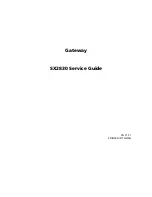
358
V6100 and V7122 User Guide
A carrier-grade alarm system is characterized by the following:
The device has a mechanism that allows a manager to determine which alarms are
currently active in the device. That is, the device maintains an active alarm table.
The device has a mechanism to allow a manager to detect lost alarm raise and clear
notifications [sequence number in trap, current sequence number MIB object].
The device has a mechanism to allow a manager to recover lost alarm raise and clear
notifications [maintains a log history].
The device sends a cold start trap to indicate that it is starting. This allows the EMS to
synchronize its view of the device's active alarms.
The SNMP alarm traps are sent as in previous releases. This system provides the
mechanism for viewing of history and current active alarm information.
Active Alarm Table
The device maintains an active alarm table to allow a manager to determine which alarms
are currently active in the device. Two views of the active alarm table are supported by the
agent:
acActiveAlarmTable
in
the enterprise acAlarm
alarmActiveTable and alarmActiveVariableTable in the IETF standard ALARM-MIB
(rooted in the AC tree)
The acActiveAlarmTable is a simple, one-row per alarm table that is easy to view with a MIB
browser.
The ALARM-MIB is currently a draft standard and therefore has no OID assigned to it. In the
current software release, the MIB is rooted in the experimental MIB subtree. In a future
release, after the MIB has been ratified and an OID assigned, it is to move to the official OID.
Alarm History
The device maintains a history of alarms that have been raised and traps that have been
cleared to allow a manager to recover any lost, raised or cleared traps. Two views of the
alarm history table are supported by the agent:
acAlarmHistoryTable
in the enterprise acAlarm
nlmLogTable and nlmLogVariableTable in the standard NOTIFICATION-LOG-MIB
As with the acActiveAlarmTable, the acAlarmHistoryTable is a simple, one-row-per-alarm
table that is easy to view with a MIB browser.
Содержание TP-1610
Страница 28: ...28 V6100 and V7122 User Guide Reader s Notes ...
Страница 48: ...48 V6100 and V7122 User Guide Reader s Notes ...
Страница 72: ...72 V6100 and V7122 User Guide Reader s Notes ...
Страница 80: ...80 V6100 and V7122 User Guide Reader s Notes ...
Страница 151: ...V6100 and V7122 User Guide 151 Figure 83 Log off Prompt 2 Click OK in the prompt the Web session is logged off ...
Страница 152: ...152 V6100 and V7122 User Guide Reader s Notes ...
Страница 262: ...262 V6100 and V7122 User Guide Reader s Notes ...
Страница 284: ...284 V6100 and V7122 User Guide Reader s Notes ...
Страница 291: ...V6100 and V7122 User Guide 291 Figure 95 V7122 Startup Process ...
Страница 324: ...324 V6100 and V7122 User Guide Reader s Notes ...
Страница 354: ...354 V6100 and V7122 User Guide Reader s Notes ...
Страница 374: ...374 V6100 and V7122 User Guide Reader s Notes ...
Страница 382: ...382 V6100 and V7122 User Guide Figure 130 Example of a User Information File Reader s Notes ...
Страница 392: ...392 V6100 and V7122 User Guide Reader s Notes ...
Страница 409: ...V6100 and V7122 User Guide 409 Reader s Notes ...
Страница 413: ...V6100 and V7122 User Guide 413 Reader s Notes ...
Страница 425: ...V6100 and V7122 User Guide 425 Figure 145 UDP2File Utility Reader s Notes ...
Страница 431: ...V6100 and V7122 User Guide 431 Reader s Notes ...
Страница 447: ...V6100 and V7122 User Guide 447 Reader s Notes ...
Страница 449: ...V6100 and V7122 User Guide 449 Figure 146 Connection Module CM Figure 147 OSN Server Figure 148 Hard Drive Module HDMX ...
Страница 483: ...V6100 and V7122 User Guide 483 Reader s Notes ...
















































